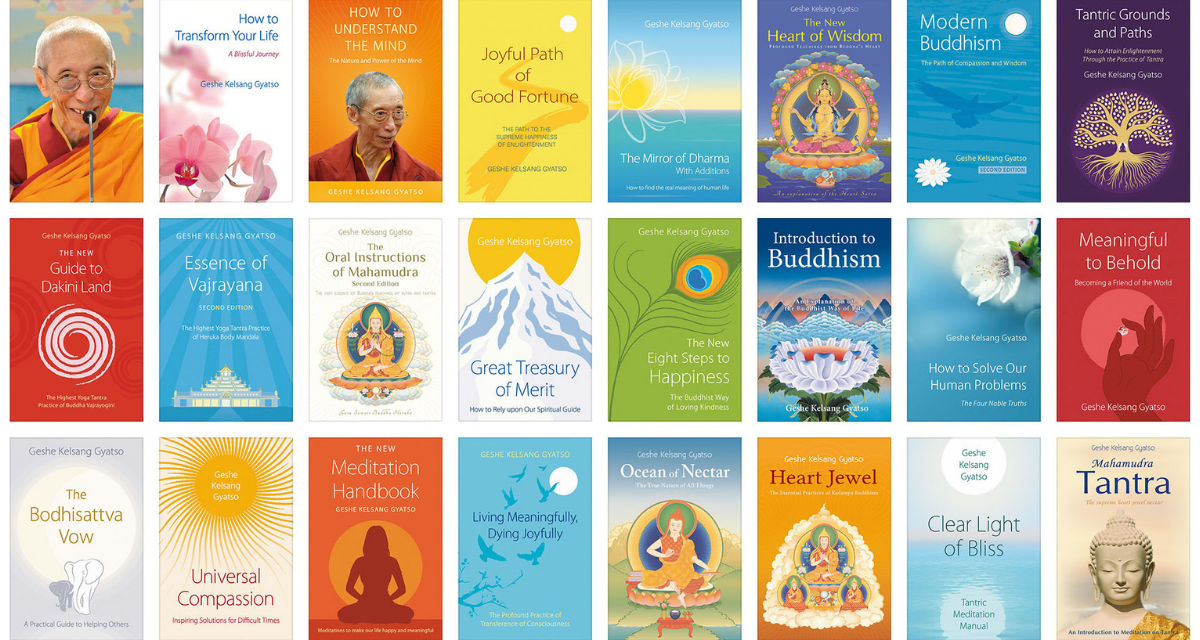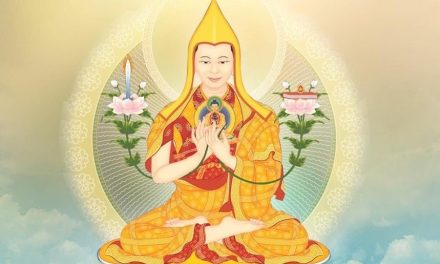During his life, Venerable Geshe Kelsang Gyatso authored 23 books that cover all aspects of Buddhism, providing practical and scholarly guidance on how to enter the path to liberation and enlightenment, how to progress along it, and how to complete it. Some of these books are introductory texts, some are commentaries to major works of past Buddhist masters, some are commentaries on Buddhist philosophy, and some are lucid commentaries to advanced Tantric practices.
These books are generally well regarded in the Buddhist world, and also form the basis of the three New Kadampa Tradition (NKT) study programs that are followed by thousands of students worldwide. Here is some background.
Buddhism
Buddhism is the practice of Buddha Shakyamuni’s 84,000 teachings. The purpose of Buddha’s teachings (Dharma) is to provide guidance that helps us to develop our own innate potential for compassion and wisdom, which is the solution to our daily problems of ignorance, depression, anger, and so on. Through this we can find a happy and meaningful life, and truly help others.
Eventually, through practicing Buddha’s teachings we can reach the highest spiritual goals of permanent inner peace and, finally, enlightenment. This is considered in Buddhism to be the highest spiritual achievement of human life, attainable by anyone who practices Dharma.
Geshe Kelsang’s 23 books provide a complete, clear, and practical presentation of all of Buddha’s teachings, designed especially for people of the modern world.
Kadampa Buddhism
Kadampa Buddhism is a special presentation of Buddha’s teachings that come from great meditation masters of India and Tibet — in particular the Indian Pandit Atisha (CE 982-1054) and the Tibetan spiritual master Je Tsongkhapa Losang Dragpa (CE 1357-1419). This is a very practical presentation that clarifies all of Buddha’s teachings.
‘Ka’ refers to Buddha’s teachings and ‘dam’ refers to Atisha’s instructions on Lamrim (the stages of the path to enlightenment, also known as ‘Kadam Lamrim’). ‘Kadam’ therefore refers to the union of Buddha’s teachings and Atisha’s instructions, and practitioners of Kadam Lamrim are called ‘Kadampas’.
The Buddhist master Mahasiddha Menkhangpa said:
The unmistaken Dharma is Lamrim, Lojong and Mahamudra.
Kadampa Buddhism contains these 3 practices. Lamrim and Lojong (training the mind) are preliminary practices, and Mahamudra is the actual quick path to enlightenment. Geshe Kelsang’s books explain in great detail how to practice these.
An authentic lineage
In all Buddhist traditions, it is important to be able to trace the teachings back to an authentic source and ultimately to Buddha Shakyamuni himself. In several of his books, including Great Treasury of Merit, Geshe Kelsang names all the lineage teachers who have gained full experience and passed on the instructions of Kadampa Buddhism, generation after generation, an unbroken lineage from Buddha to the present day.
The collected works of Venerable Geshe Kelsang Gyatso
Geshe Kelsang’s 23 books explain the entire teachings of Buddha, from lucid introductory explanations aimed at beginners to the most advanced instructions of Tantra that lead directly to enlightenment. His books, in the suggested order of study for beginners, are:
How to Transform Your Life
How to Understand the Mind
Joyful Path of Good Fortune
The New Heart of Wisdom
Modern Buddhism
Tantric Grounds and Paths
The New Guide to Dakini Land
Essence of Vajrayana
The Oral Instructions of Mahamudra
Great Treasury of Merit
The New Eight Steps to Happiness
Introduction to Buddhism
How to Solve Our Human Problems
Meaningful to Behold
The Bodhisattva Vow
Universal Compassion
The New Meditation Handbook
Living Meaningfully, Dying Joyfully
Ocean of Nectar
Heart Jewel
Clear Light of Bliss
Mahamudra Tantra
Free eBooks
If you are interested in checking these out, Geshe Kelsang offered two of his books as gifts to anyone who might like them. Click on these links:
Modern Buddhism
How to Transform Your Life
A unique body of work
It is not easy to find another author in the modern Buddhist world who has composed a series of books which, viewed as a whole, provides a comprehensive presentation of the entire Buddhist path to enlightenment.
For people today, Geshe Kelsang’s works provide a key that opens the door to a complete and accessible Buddhist practice from the point of view of the Tibetan Master Je Tsongkhapa’s tradition. As such, they are highly valued amongst Kadampa Buddhists and others.
Tibetan masters, publishers, and Buddhist reviewers have all praised Geshe Kelsang’s explanations. Here are a few examples.
Yongdzin Ling Rinpoche, the senior tutor to the 14th Dalai Lama, wrote the Foreword to Geshe Kelsang’s first published book, entitled Clear Light of Bliss. In it, he says:
This excellent commentary on the joyous Mahamudra
Derived from churning the essence of the ocean of Tantric scriptures
That arose from the heart of this most precious Spiritual Guide
Is published with a pure wish to benefit migrators.
Geshe Kelsang’s Spiritual Guide, Vajradhara Trijang Rinpoche, wrote the Foreword to Geshe Kelsang’s commentary to Bodhisattva Shantideva’s Guide to the Bodhisattva’s Way of Life, entitled Meaningful to Behold.
The excellent expounder, the great Spiritual Master Kelsang Gyatso, studied myriad Buddhist scriptures at the famous Je College of the great monastic university of Sera, Tegchen Ling, practised the meaning of the teachings he received, and became a wise, serious and realized Teacher …
This text is the heart essence of all the Sugatas of the three times and is the unsurpassed practice of the great Sons of the Conquerors…..as a great gathering of the paths of the Mahayana tradition, it is therefore worthy to receive many flowers of praise bestowed with appreciation.
This is praise from Geshe Kelsang’s own teachers who taught him at the monastic university of Sera-je.
Some other reviews
I am happy that Geshe Kelsang Gyatso has attempted to present the basic teachings of Lord Buddha in a manner that people can relate to and put into practice in their daily lives. I would like to thank the translator and editors for their efforts. ~ HH The Dalai Lama
Foreword to Buddhism in the Tibetan Tradition (published by Routledge)
At times his insights are penetrating and his illustrations compelling, as when he explains that patient acceptance—far from being passive—requires strength and courage to resist “well-worn mental grooves of intolerance”.
Review of How to Solve our Human Problems, Publishers’ Weekly.
This is a calming, informative look at Buddhism.
Review of Introduction to Buddhism, Publisher’s Weekly.
This book is a guide to learning how to shift one’s perspective in order to be more compassionate towards all livings beings. It is simply written and brought me to tears multiple times!
Review of How to Transform Your Life, Goodreads.
This is written in the same vein as Eight Steps to Happiness in that it comes from ancient verses and poems, but it shows us how to incorporate it into our daily lives. It follows on from Eight Steps to Happiness by developing love and compassion but gives us a framework for how to do it. If you’re looking for a set of ‘rules’ for what to do, this is it.
Review of Universal Compassion, on the website Buddhist Thoughts.
It provides a very comprehensive way to bring Buddhist principles into our daily lives.
Review of The New Meditation Handbook on the website Buddhist Thoughts.






If Kelsang Gyatso could hardly string a word together in English, how could he have written all of these books?
Don’t be a cult and delete this comment; just answer my question!
Not sure how to answer this other than to say that your premise is incorrect: Venerable Geshe Kelsang obviously could string a word together in English because he taught extensively for many years in English to thousands and thousands of students, and he wrote most of his books in English.
His early teachings and the first 2 or 3 books were translated from Tibetan into English, but after he had learned English the rest of his books were composed in English. Some were based on his oral teachings and some he wrote from scratch.
I’d also add that in the past, as a part of the centre management team I participated in meetings with Geshe-la where discussions went from personal topics like well being, baking bread!, also some dharma teachings and of course the planning of the centre. Geshe-la had more than good enough English to listen to and articulate a very thorough and helpful understanding of critical admin tasks, including I remember we discussed stuff like parking issues, fundraising, mortgages, estate agents, prospective properties and plans for future dharma centre development etc. I should add he always had something valuable to contribute or helped us look at the issues or priorities differently if we were getting stuck on a particular point (even if it was to remind us not to worry! Just try our best). We would also discuss planning the teaching program, publicity etc again his reaction and suggestions regarding what we had done or were planning were really helpful and I still use much of his advice to this day.
The meetings were peppered with jokes, some affectionate comments or questions for students he had known a long time and of whom he knew their history, family connections etc. In short, I can confirm Geshe-la had a full knowledge of English to an exceedingly high level – at no point did we have to modify our speech, simplify expressions or slow down in order to make our selves understood.
I thought this comment from Tsem Rinpoche (from his blog) regarding his experience of Geshe-la’s books was very helpful, giving the perspective of someone who studied in the Tibetan monasteries.
“when I came across Geshe Kelsang Gyatso’s books, I was just totally amazed at their accuracy, clarity, incredible consistency and especially its progression, meaning from steps A to Z. When you read these books, nothing of Geshe’s personal interpretation is in there, it’s pretty much according to the scriptures if you can read Tibetan. There are some exceptions when he puts in examples here and there to help elucidate what’s there, but the actual body of the text and the meat and the bones, are very accurate. And I was amazed because I had problems learning Tibetan, reading Tibetan and I actually do not prefer to study in Tibetan. I prefer to study in English for whatever karmic reason there is in that. So when I read Geshela’s books and commentaries, they really illuminated my world, they really gave me a lot of knowledge, they really opened me up to so much more in Dharma.
And I remember 20 years back when I was giving teachings to people, I would actually use some of Geshela’s books as the basis of my teachings. People said that it was helpful and beneficial… In fact, it was helpful for me! So therefore I have always admired the knowledge this great master has and the knowledge that he passed to his students, to be able to translate these and make these teachings available to the world. I have always been in great admiration for Geshela’s scholarship, his knowledge, and erudite preciseness in training his students to produce these types of books and teachings that have been so beneficial for so many people around the world.
My admiration grew for Geshela from these books. In the past I have personally purchased hundreds of these book, hundreds and hundreds, if not thousands, and passed it to people, offered it to people and giving it to people as guidelines of certain practices. They have been very beneficial. For example, Geshela’s tantric text on Heruka and Vajrayogini are absolutely priceless. One of my favourite books is ‘Understanding Your Mind‘ by Geshela… that’s really one of my favourites. And I think one book that really changed my mind to develop and gear myself more towards the development of compassion was Geshela’s translation of Shantideva’s text ‘The Bodhisattva-charya-avatara‘ or Meaningful to Behold. That really affected me quite a lot when I read it, and it moved me very very much.” from (https://www.tsemrinpoche.com/tsem-tulku-rinpoche/great-lamas-masters/a-gift-from-geshe-kelsang-gyatso.html?source=post_page—–ae7c0a079ad7——————————–)